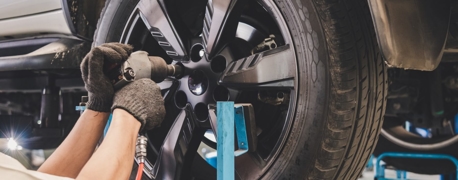Should Cell Phones Be Banned While Driving?

Distracted driving is one of the most common causes of crashes in the United States, second only to drunk driving. According to the National Safety Council, approximately 26% of all car crashes involve cell phones. Meanwhile, approximately 30% of all fatal crashes involve an impaired driver.
In this blog, we will dive into the dangers of using a cell phone while driving—for both consumers and commercial drivers.
The Dangers of Distracted Driving
Every year, nearly 400,000 injuries are a direct result of crashes caused by texting and driving. In fact, one in four crashes in the U.S. is caused by texting and driving.
So what is being done about this?
Driver cell phone use is restricted at the state level, rather than federally. This means that it’s up to each state to define its laws to combat the dangers of distracted driving. At the time of this writing, no state bans the hands-free use of cell phones among adult drivers, although 36 states (and Washington, D.C.) prohibit novice and teen drivers from all cell phone use. Meanwhile, 24 states—as well as Washington, D.C., Guam, Northern Mariana Islands, Puerto Rico, and the U.S. Virgin Islands—strictly limit drivers from handheld cell phone use.
However, while these laws might decrease the amount of cellphone use while driving, some experts are claiming that they do not decrease accidents.
Do Cell Phone Bans Reduce Accidents? What Research Says
According to a 2009 analysis by the Highway Loss Data Institute (HLDI), states with hand-held cellphone bans while driving had no change in the rates of insurance claims. Another 2010 analysis also found that texting bans also failed to change the rate of insurance claims.
The National Highway Traffic Safety Administration (NHTSA) has supported enforcement programs in Connecticut and New York. During periods of increased enforcement, observed cellphone users dropped 57 percent in Connecticut and up to 40 percent in New York. However, Adrian Lund, president of HLDI, is not convinced that decreased phone usage reduces accidents.
"NHTSA's study was well-done," Lund commented. "It shows that good enforcement can change driver behavior. However, the question remains, is changing driver behavior enough to affect crash rates?"
HLDI tested the effectiveness of these enforcement periods by looking at reported crashes to insurers in the same areas as the NHTSA-sponsored programs. By looking at claims, HLDI determined that there was no corresponding reduction in crashes.
What Causes Cellphone Bans to Fail?
Analysts believe that cellphone bans might not prevent accidents because they cause people to change how they use their phones. If visible cellphone use can get a driver in trouble, they might choose to use a hands-free system that is still distracting. Research from the National Safety Council has found that hands-free cellphone use is still dangerous.
“While many drivers honestly believe they are making the safe choice by using a hands-free device, it’s just not true,” said NSC senior director David Teater. “The problem is the brain does not truly multi-task. Just like you can’t read a book and talk on the phone, you can’t safely operate a vehicle and talk on the phone. With some state laws focusing on handheld bans and carmakers putting hands-free technology in vehicles, no wonder people are confused.”
Cell Phone Use for Commercial Drivers
These types of restrictions are nothing new in the commercial space. Over the last 20 years, several Fortune 500 companies have banned cell phone use for their commercial drivers, including UPS, DuPont, Chevron, Shell, and Time Warner (now Spectrum), according to a Washington Post article from 2012. Some have taken it a step further, like Chevron, which has disallowed cell phone use within 25 feet of the vehicle; as of 2021, Chevron strictly prohibits it while the vehicle is in motion.
These policies were implemented in response to the dangers that cell phones pose to drivers of commercial vehicles and those who share the road with them.
Even with the advent of hands-free technology, many companies hold firm against cell phone use, and have for some time. Shell, for example, put a global ban into place restricting taking/making phone calls while driving in 2002 in response to an increase in roadway fatalities in the late 1990s. This applied in the approximately 90 countries where Shell operates, although many of them don’t have laws that ban cell phone use. In 2004, the ban was stretched to include texting and hands-free devices. In 2009, the employee handbook advertised a new policy: all cell phone use is strictly prohibited.
The company even promotes this rhetoric to the public in the Health, Security, Safety and the Environment section on their website. On this page, they share statistics, warnings, and safe driving tips.
Of the 150 Fortune 500 companies that the National Safety Council contacted in 2011 regarding their cell phone policies, only 20% had a full ban in place. Oil companies like Shell led the charge on this front, being among the first to ban both handheld and hands-free cell phone use while driving.
Although using a cell phone hands-free is safer than handheld, companies such as Cargill restrict their employees’ use of devices in the car completely. In a 2017 statement, the company introduced its enhanced Safe Driving Policy:
“It puts a total ban on using mobile phones for company business while driving, whether in a personal vehicle or a Cargill-owned vehicle. The ban also applies to hands-free devices, as more than 30 studies have found hands-free options pose significant risks as well, because they don’t eliminate mental distractions.”
The last part of their statement quoted here comes almost verbatim from the National Safety Council’s 2015 report, which states, “More than 30 research studies have found that hands-free devices offer no safety benefit, because these hands-free devices do not eliminate the cognitive distraction of conversation.”
Lawsuits & Cell Phone Use
One of the first major companies that faced the repercussions of a driver using a cell phone while driving was Coca-Cola. The company faced a distracted driving lawsuit when a woman was seriously injured after being struck by a Coca-Cola Refreshments truck in 2010. The driver of the truck was found to have been talking on the phone using hands-free technology at the time of the accident, and turned left into oncoming traffic, crushing the woman’s car. The spine injury she suffered in the accident required back surgery. Coca-Cola’s negligence in warning and educating their drivers on the dangers of cell phone use rendered a $21 million verdict from a Corpus Christi jury, although the company had argued that its policies abided with Texas law.
This verdict caused Coca-Cola to reconsider its cell phone policies.
However, it is not the only time that such an accident has been caused by drivers distracted by hands-free devices.
- In 2004, a private tour bus struck a bridge on the George Washington Memorial Parkway in Alexandria, Virginia. The driver was talking on a hands-free cell phone at the time and did not see the warning signs that the bridge was nearly two feet too low for the bus to pass safely in the right lane. The crash destroyed the bus roof and injured 11 students.
- In 2002, a construction company employee used a hands-free device to retrieve a message from his employer and was distracted enough that he crashed into a sedan that had stopped to turn left. A passenger in the sedan was severely injured. Although the company argued that the driver was commuting to his job at the time of the crash, it was determined that the cell phone was provided by the company. The settlement was $5 million, $4.75 million of which was the employer’s fine.
- In 2013, a transportation company employee struck and killed a pedestrian while driving a semi-truck. The driver was talking to his employer on a hands-free device at the time of the crash, and it was found that the company allowed hands-free use. The company settled the lawsuit.
In 2015, the AAA Foundation for Traffic Safety published a study that showed that drivers can still be distracted when using hands-free technology when compared to handheld, such as texting and driving. In fact, the distraction caused by using these devices can last up to 27 seconds after the driver has finished making a call or texting via voice commands.
Call Arnold & Itkin if You’ve Suffered Because of a Distracted Driver
If you’ve suffered because of a driver who was using their phone and caused an accident, help is available. Arnold & Itkin has won billions of dollars for our clients. Our car accident attorneys have done this through a commitment to justice and never settling for less than our clients deserve. While we can’t prevent distracted drivers from changing lives, we can fight to hold them accountable for doing so.
Call us today for a free consultation. A member of our team is standing by 24/7 to take your call and help you explore your options at (888) 493-1629


